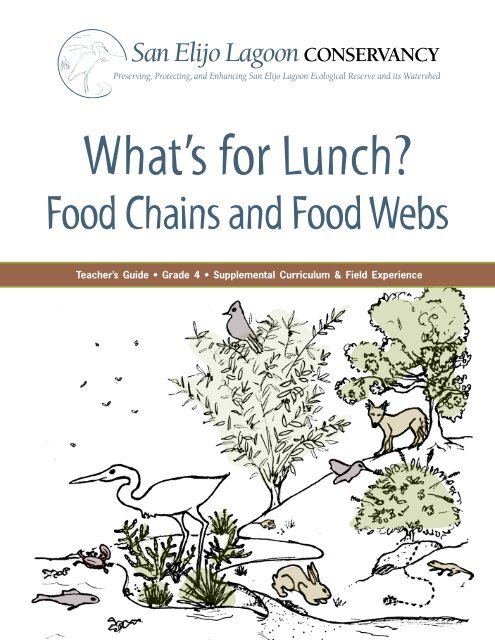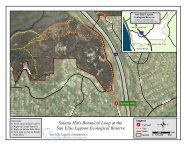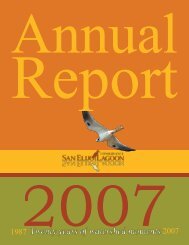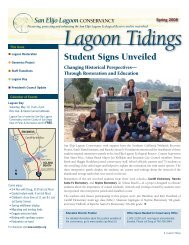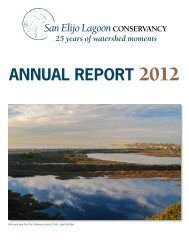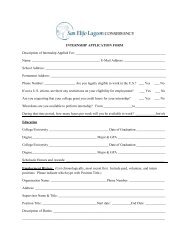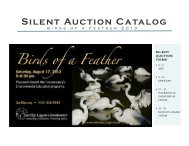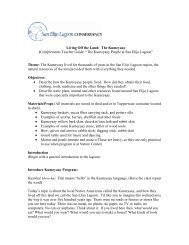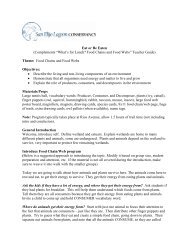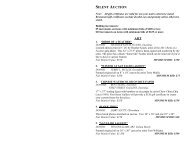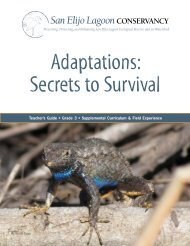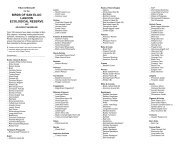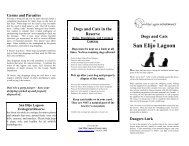Food Chains and Food Webs - San Elijo Lagoon Conservancy
Food Chains and Food Webs - San Elijo Lagoon Conservancy
Food Chains and Food Webs - San Elijo Lagoon Conservancy
Create successful ePaper yourself
Turn your PDF publications into a flip-book with our unique Google optimized e-Paper software.
What’s for Lunch?<br />
<strong>Food</strong> <strong>Chains</strong> <strong>and</strong> <strong>Food</strong> <strong>Webs</strong><br />
Teacher’s Guide • Grade 4 • Supplemental Curriculum & Field Experience
TEACHER OVERVIEW<br />
Objectives<br />
From the information <strong>and</strong> activities in this packet, students will gain:<br />
• An underst<strong>and</strong>ing of what food chains <strong>and</strong> food webs are <strong>and</strong> how they work.<br />
• An awareness of the food webs of several <strong>San</strong> <strong>Elijo</strong> <strong>Lagoon</strong> habitats <strong>and</strong> how they’re linked.<br />
• Familiarity with some of the plants <strong>and</strong> animals that rely on the lagoon for their survival.<br />
California State St<strong>and</strong>ards<br />
This packet will assist you in meeting these Science Content St<strong>and</strong>ards for California Public Schools,<br />
which focus on organisms’ need for energy <strong>and</strong> matter to live <strong>and</strong> grow <strong>and</strong> their dependence on one<br />
another <strong>and</strong> their environment for survival.<br />
4.2a.<br />
4.2b.<br />
4.2c.<br />
4.3a.<br />
Students know plants are the primary source of matter <strong>and</strong> energy entering<br />
most food chains.<br />
Students know producers <strong>and</strong> consumers (herbivores, carnivores, omnivores,<br />
<strong>and</strong> decomposers) are related in food chains <strong>and</strong> food webs <strong>and</strong> may compete<br />
with each other for resources in an ecosystem.<br />
Students know decomposers, including many fungi, insects, <strong>and</strong><br />
microorganisms, recycle matter from dead plants <strong>and</strong> animals.<br />
Students know that ecosystems can be characterized by their living <strong>and</strong><br />
nonliving components.<br />
Vocabulary<br />
abiotic<br />
algae<br />
bacteria<br />
biotic<br />
carnivore<br />
non-living components of an ecosystem; something that was never alive<br />
photosynthetic organisms, ranging in size from giant kelp to<br />
microscopic phytoplankton, that serve as food for many animals,<br />
including those in the lagoon (plural, algae; singular, alga)<br />
microscopic, single-celled organisms that serve many ecological roles,<br />
some harmful <strong>and</strong> some helpful, including breaking down organic<br />
matter (e.g., dead leaves) <strong>and</strong> releasing nutrients into the environment<br />
(plural, bacteria; singular, bacterium)<br />
living components of an ecosystem, such as the plants <strong>and</strong> animals<br />
an animal that eats only other animals (e.g., hawk or lizard)<br />
<strong>San</strong> <strong>Elijo</strong> <strong>Lagoon</strong> <strong>Conservancy</strong> | <strong>Food</strong> <strong>Chains</strong> & <strong>Food</strong> <strong>Webs</strong> Teacher’s Guide | Page 1
TEACHER OVERVIEW continued<br />
coastal sage scrub a habitat growing on drier coastal slopes that consists of droughtresistant<br />
shrubs <strong>and</strong> other plants<br />
component<br />
consumer<br />
decomposer<br />
ecosystem<br />
energy<br />
food chain<br />
food web<br />
fungi<br />
habitat<br />
herbivore<br />
lagoon<br />
nutrient<br />
omnivore<br />
photosynthesis<br />
phytoplankton<br />
producer<br />
riparian<br />
salt marsh<br />
species<br />
wetl<strong>and</strong><br />
a part of something; a smaller part of a larger entity or system<br />
an animal that gets its energy by eating other plants or animals<br />
a living thing (organism) that breaks down the remains of dead<br />
organisms (e.g., some insects, crabs, fungi, or bacteria)<br />
all the living <strong>and</strong> nonliving things that interact in an area<br />
the capacity to be active, or, as defined in physics, to do work<br />
the path of food energy in an ecosystem from sunlight to plants to animals<br />
a system of interconnected food chains<br />
a group of organisms, including mushrooms, yeast, <strong>and</strong> mold, which<br />
feeds on living <strong>and</strong> dead organic matter or material (plural, fungi;<br />
singular, fungus)<br />
a specific type of environment inhabited by particular animal <strong>and</strong><br />
plant species<br />
an animal that eats only plants (e.g., rabbit or deer)<br />
a body of water cut off from another larger body of water by s<strong>and</strong>,<br />
coral or reef<br />
a substance that living things need to live <strong>and</strong> grow<br />
an animal that can eat both plants <strong>and</strong> animals (e.g., skunk, raccoon,<br />
chicken, or human)<br />
the process by which a plant makes its food from sunlight<br />
plankton that are plants or are photosynthetic<br />
an organism that makes its own food using energy usually from sunlight<br />
a type of wetl<strong>and</strong> near or along the banks of a river, stream or lake<br />
a type of wetl<strong>and</strong> habitat growing in or near salt water<br />
a group of the same type of living things that can mate <strong>and</strong> produce<br />
other living things of the same kind<br />
an area that is covered by water during all or some part of the year<br />
<strong>San</strong> <strong>Elijo</strong> <strong>Lagoon</strong> <strong>Conservancy</strong> | <strong>Food</strong> <strong>Chains</strong> & <strong>Food</strong> <strong>Webs</strong> Teacher’s Guide | Page 2
TEACHER OVERVIEW continued<br />
Introduction<br />
Where Do You Get Your Energy?<br />
What did you (or your students) have for breakfast today? Was it cereal <strong>and</strong> milk, or bacon <strong>and</strong><br />
eggs, or eggs with tortillas <strong>and</strong> salsa (huevos rancheros)? Why is eating breakfast, or any meal,<br />
important? We eat food for the energy it provides to get us through the day.<br />
Breakfast, or any meal or snack, is part of an energy transfer chain called a food chain. A good<br />
way to underst<strong>and</strong> a food chain <strong>and</strong> how energy gets transferred is to show one. This is an<br />
illustration of a human breakfast food chain.<br />
<strong>Food</strong> Chain<br />
energy from the sun<br />
(along with water <strong>and</strong><br />
nutrients for photosynthesis)<br />
consumer<br />
you & me<br />
cereal<br />
producer<br />
plant (corn)<br />
huevos rancheros<br />
consumer<br />
animals (chicken)<br />
<strong>San</strong> <strong>Elijo</strong> <strong>Lagoon</strong> <strong>Conservancy</strong> | <strong>Food</strong> <strong>Chains</strong> & <strong>Food</strong> <strong>Webs</strong> Teacher’s Guide | Page 3
TEACHER OVERVIEW continued<br />
Starting this food chain with you, the diagram links you to the eggs you may have eaten <strong>and</strong><br />
the animal they came from — eggs from chickens. The arrow points from the chicken to you<br />
because the energy is transferred from the chicken to you. What did the chicken eat? In this food<br />
chain, the chicken ate corn <strong>and</strong> so the diagram shows the link from the chicken to the plant with<br />
the transfer of energy (arrow) flowing from plant to chicken. And the plant is linked to the sun.<br />
Starting with sunlight, energy flows to plants through the process called photosynthesis. This<br />
food chain shows how energy is transferred from the sun to plants to animals to you.<br />
What if you just had cereal or pancakes or tortillas? As you see in the illustration, the food chain<br />
is shorter <strong>and</strong> shows the energy transfer from the sun to plants to you.<br />
(Note: Some of your students may not know where their food comes from. You may need to use<br />
pictures or videos to show how we get eggs from chickens or milk from cows, <strong>and</strong> how plants,<br />
such as corn or wheat, are made into flour <strong>and</strong> the flour used to make cereals, breads, pancakes,<br />
<strong>and</strong> tortillas. This may be important before continuing to teach about food chains <strong>and</strong> webs.)<br />
Because every living thing on Earth needs energy to live, grow <strong>and</strong> reproduce, every living<br />
thing is part of a food chain. Within every ecosystem there are many food chains that overlap.<br />
Overlapping <strong>and</strong> linked food chains create a complex food web in which every plant <strong>and</strong> animal<br />
plays a role (see illustration on page 6).<br />
Our role in a food web is as a consumer. A chicken is a consumer as well. We both consume or<br />
eat things to get our energy. All consumers rely on producers. Producers are the starting point<br />
for all food chains <strong>and</strong> food webs because they make their own food from sunlight, along with<br />
water <strong>and</strong> nutrients. That food-making process is called photosynthesis. On l<strong>and</strong>, plants are the<br />
foundation of the food web. In the lagoon, algae <strong>and</strong> tiny drifting plants called phytoplankton<br />
are the foundation of the aquatic food web. Consumers couldn’t live without producers.<br />
Within a food web, there are different kinds of consumers. Rabbits <strong>and</strong> deer can eat only plants<br />
<strong>and</strong> so are a type of consumer called an herbivore (based on the Latin word roots herb for grass<br />
or plants <strong>and</strong> vor for eat). Some animals, such as hawks, egrets, <strong>and</strong> lizards, eat other animals.<br />
Animals that eat only other animals are called carnivores (carn for flesh or meat <strong>and</strong> vor for eat).<br />
Some animals eat a variety of foods. Chickens eat corn, seeds, <strong>and</strong> insects. Humans can eat plants<br />
<strong>and</strong> animals for energy (although some people choose not to eat animals). Animals that eat a<br />
variety of foods are called omnivores (omni for all <strong>and</strong> vor for eat). Omnivores, carnivores, <strong>and</strong><br />
herbivores are all consumers.<br />
There is one other group of organisms that play a very important role in a food web. They are<br />
the decomposers—nature’s recyclers. Decomposers feed on decaying plants <strong>and</strong> animals or on<br />
animal wastes. These recyclers can be large, such as a turkey vulture, or small, such as ants or<br />
crabs. And some can be very small, sometimes too small to see easily, such as bacteria or fungi.<br />
You can see tiny decomposers at work when you see mold on bread or find fruit rotting. All<br />
decomposers have a role in breaking down animal <strong>and</strong> plant remains, thereby enriching the soil<br />
with nutrients. The recycling of nutrients enables more plants, the producers, to grow. It also<br />
helps clean up an ecosystem, which keeps it healthy. If there weren’t any decomposers, imagine<br />
the pile up of wastes that would occur.<br />
<strong>San</strong> <strong>Elijo</strong> <strong>Lagoon</strong> <strong>Conservancy</strong> | <strong>Food</strong> <strong>Chains</strong> & <strong>Food</strong> <strong>Webs</strong> Teacher’s Guide | Page 4
TEACHER OVERVIEW continued<br />
This is one of the problems with some wastes that humans make, such as plastic bottles, c<strong>and</strong>y<br />
wrappers or other trash. There are no natural decomposers that can break down <strong>and</strong> recycle<br />
most of our trash. That’s why it’s important that each of us recycles the things we can recycle,<br />
such as paper, glass, <strong>and</strong> aluminum, <strong>and</strong> even more important that we limit the use of things we<br />
can’t recycle <strong>and</strong> that never break down, such as plastics. We want to keep our ecosystem clean<br />
<strong>and</strong> healthy for ourselves <strong>and</strong> the other organisms that share this planet with us.<br />
In addition to the living (or biotic) components of an ecosystem, there are also non-living<br />
(abiotic) components. The main energy source for almost all food webs is the sun. The sun is<br />
one of the abiotic components of an ecosystem. Other non-living components are the air, soil,<br />
<strong>and</strong> water. Every ecosystem is made up of abiotic <strong>and</strong> biotic components that interact <strong>and</strong> it is<br />
that interaction that makes an area unique <strong>and</strong> productive.<br />
When you visit <strong>San</strong> <strong>Elijo</strong> <strong>Lagoon</strong>, you will learn details about some of the biotic <strong>and</strong> abiotic<br />
components of at least three different habitats: salt marsh, riparian forest, <strong>and</strong> coastal sage<br />
scrub. The salt marsh is washed by salty ocean water when the mouth of the lagoon is open,<br />
creating a succulent, salt-tolerant, low-growing, wetl<strong>and</strong> plant community. Where there is fresh<br />
water flowing in streams <strong>and</strong> drainages, you’ll find a thicket of trees <strong>and</strong> shrubs of the riparian<br />
forest near the wetl<strong>and</strong>. Coastal sage scrub is composed of drought-resistant shrubs <strong>and</strong> other<br />
plants that grow on drier coastal slopes.<br />
Why are these habitats so different? It’s because their abiotic components, especially water <strong>and</strong><br />
soils, are different. Abiotic components play a major role in determining what plant communities<br />
survive, which in turn determine which animals will live there. These interactions result in<br />
different food webs as well. Where there are different habitats close together, as there are at <strong>San</strong><br />
<strong>Elijo</strong> <strong>Lagoon</strong>, the food webs of each overlap creating a very complex system (see illustration on<br />
page 6).<br />
To summarize, why is it important to underst<strong>and</strong> how the biotic <strong>and</strong> abiotic components of<br />
a community interact? It’s because both components are important within any ecosystem. A<br />
break in any part of a single food chain can negatively impact the entire food web <strong>and</strong> harm the<br />
entire ecosystem.<br />
References <strong>and</strong> Suggested Readings<br />
For more information, look for these references at a local library or online.<br />
Baders, W. & Carnine, D. 2007. Houghton Mifflin California Science. Orl<strong>and</strong>o, FL: Houghton Mifflin.<br />
Kalman, B. 1998. What Are <strong>Food</strong> <strong>Chains</strong> & <strong>Webs</strong>? New York, NY: Crabtree Publishing Company.<br />
Kalman, B. 2007. Wetl<strong>and</strong> <strong>Food</strong> Chain. New York, NY: Crabtree Publishing Company.<br />
<strong>San</strong> <strong>Elijo</strong> <strong>Lagoon</strong> <strong>Conservancy</strong> website: www.sanelijo.org<br />
Silverstein, A., Silverstein, V. & Nunn, L.S. 2008. <strong>Food</strong> <strong>Chains</strong>. Minneapolis, MN: Twenty-first Century Books.<br />
Stienstra, T. 2000. California Wildlife: A practical guide. Emeryville, CA: Avalon Travel Publishing, Inc.<br />
<strong>San</strong> <strong>Elijo</strong> <strong>Lagoon</strong> <strong>Conservancy</strong> | <strong>Food</strong> <strong>Chains</strong> & <strong>Food</strong> <strong>Webs</strong> Teacher’s Guide | Page 5
TEACHER OVERVIEW continued<br />
<strong>Food</strong> Web<br />
Salt Marsh Riparian Coastal Sage Scrub<br />
energy from<br />
the sun<br />
hawk<br />
phoebe<br />
lemonadeberry<br />
flies<br />
coyote<br />
willow<br />
pickleweed<br />
egret<br />
mouse<br />
hummingbird<br />
black<br />
sage<br />
seed<br />
fish<br />
crab<br />
rabbit<br />
grass<br />
ants<br />
lizard<br />
algae<br />
<strong>San</strong> <strong>Elijo</strong> <strong>Lagoon</strong> <strong>Conservancy</strong> | <strong>Food</strong> <strong>Chains</strong> & <strong>Food</strong> <strong>Webs</strong> Teacher’s Guide | Page 6
ACTIVITIES<br />
We developed the activities in this packet to support your field trip.<br />
Pre-Visit<br />
Activities 1 <strong>and</strong> 2 are designed as pre-visit activities. We recommend you use these to familiarize your<br />
students with the concepts of living (biotic) <strong>and</strong> non-living (abiotic) things in an ecosystem <strong>and</strong> food<br />
chains that they’re a part of. This will help them connect to the food chains <strong>and</strong> food webs you will<br />
learn about from your onsite leader (docent) during your visit to <strong>San</strong> <strong>Elijo</strong> <strong>Lagoon</strong>.<br />
Post-Visit<br />
Activity 3 is designed as a post-visit activity that will help your students review what they learned<br />
about the food chains <strong>and</strong> food webs in their lives <strong>and</strong> at <strong>San</strong> <strong>Elijo</strong> <strong>Lagoon</strong>.<br />
<strong>San</strong> <strong>Elijo</strong> <strong>Lagoon</strong> <strong>Conservancy</strong> | <strong>Food</strong> <strong>Chains</strong> & <strong>Food</strong> <strong>Webs</strong> Teacher’s Guide | Page 7
ACTIVITY 1<br />
Is It Alive, Dead or Non-living?<br />
Teacher’s Aid<br />
Activity Introduction<br />
Every habitat or ecosystem is composed of living <strong>and</strong> non-living things that interact. Some of the<br />
living, or biotic, components are plants, birds, insects, fungi, <strong>and</strong> bacteria. Some of the non-living, or<br />
abiotic, components are air, soil, water, <strong>and</strong> sunlight. During this activity, your students will survey<br />
the living (biotic) <strong>and</strong> non-living (abiotic) components of their schoolyard or school campus. This<br />
will help prepare them for their visit to <strong>San</strong> <strong>Elijo</strong> <strong>Lagoon</strong>.<br />
Time & Materials<br />
• This activity should take about 45 to 60 minutes to complete.<br />
• Students can work in teams or individually.<br />
• You will need one copy of the Student Worksheet for each student or student team.<br />
Instructions to Teacher<br />
Make copies of the Student Worksheet on page 9. Give each student or group of<br />
students a copy of a worksheet.<br />
You’re going to have your students survey the schoolyard or school campus for living<br />
(biotic) <strong>and</strong> non-living (abiotic) items. After they complete the worksheet, you will<br />
discuss their observations <strong>and</strong> their answers to the questions on how the biotic <strong>and</strong><br />
abiotic factors interact in this environment.<br />
Instructions to Students (to be given verbally)<br />
Every habitat or ecosystem is composed of living (biotic) <strong>and</strong> non-living (abiotic)<br />
things. We are going to survey our schoolyard (or playground or school campus) to<br />
find the major biotic <strong>and</strong> abiotic components. I am going to give each of you (or each<br />
team) a worksheet so that you can record your survey data.<br />
Note: Review the worksheet with students so they underst<strong>and</strong> what they’re supposed to do.<br />
We will spend about 15 to 20 minutes outside conducting our survey <strong>and</strong> completing<br />
the table on your worksheets. When we come back to our classroom, I want you to<br />
answer the questions below the survey table. Then we will discuss your observations<br />
<strong>and</strong> answers to the questions.<br />
<strong>San</strong> <strong>Elijo</strong> <strong>Lagoon</strong> <strong>Conservancy</strong> | <strong>Food</strong> <strong>Chains</strong> & <strong>Food</strong> <strong>Webs</strong> Teacher’s Guide | Page 8
ACTIVITY 1<br />
Is It Alive, Dead or Non-living?<br />
Student Worksheet<br />
Instructions<br />
You are looking for living (biotic) things, such as birds, insects, or plants, <strong>and</strong> for non-living (abiotic)<br />
things such as water, dirt, or sunshine. When you find something, write the name of the item in the<br />
table. Next, add your observations, such as where you saw it <strong>and</strong> what it was doing (if alive). For<br />
each item you observe, check a box to identify if it is biotic <strong>and</strong> alive, biotic but now dead, or abiotic.<br />
When you return to the classroom, answer the questions at the bottom of the page.<br />
Questions:<br />
Did you find more biotic or abiotic items? ____________________________________________________________________<br />
Which places had the most biotic items? ____________________________________________________________________<br />
What do biotic things need to survive? ______________________________________________________________________<br />
How do the abiotic things help or harm the biotic things? _______________________________________________________<br />
______________________________________________________________________________________________________<br />
<strong>San</strong> <strong>Elijo</strong> <strong>Lagoon</strong> <strong>Conservancy</strong> | <strong>Food</strong> <strong>Chains</strong> & <strong>Food</strong> <strong>Webs</strong> Teacher’s Guide | Page 9
ACTIVITY 2<br />
My <strong>Food</strong> Chain<br />
Teacher’s Aid<br />
Activity Introduction<br />
Every living thing needs energy to survive. We get energy from the foods we eat, which makes us<br />
part of a food chain. A food chain is the transfer of energy from the sun to plants, from plants to<br />
animals, <strong>and</strong> from animals to other animals. Parts 1 <strong>and</strong> 2 of this activity engage individual students<br />
in identifying a personal food chain. Part 3 of this activity involves the entire class in building a food<br />
web from their individual food chains. This will help prepare your students for the food chains <strong>and</strong><br />
food webs they will learn about during their visit to <strong>San</strong> <strong>Elijo</strong> <strong>Lagoon</strong>.<br />
Time & Materials<br />
• This activity should take about 30 to 60 minutes to complete. You may want to conduct it over<br />
two class periods.<br />
• Students will work initially individually on their worksheets. Then they’ll work together as a class.<br />
• You will need one copy of the Student Worksheet (both sides) for each student.<br />
Instructions to Teacher<br />
Make copies of the Student Worksheet (2 sides) on pages 13 & 14. Give each student<br />
a copy.<br />
For Part 1, choose a meal (e.g., lunch) <strong>and</strong> have your students record everything they<br />
ate during that meal. (You could also assign this as homework <strong>and</strong> have students<br />
record breakfast or dinner. You’ll need to modify the wording of the instructions if<br />
you choose another meal.)<br />
For Part 2, after they have completed Worksheet 1, have them draw their personal<br />
food chain linking the sun to plants to animals to themselves on Worksheet 2. Make<br />
sure their links have arrows showing the flow of energy from sun to plants to animals<br />
(see the illustration in this packet’s Introduction).<br />
Finally, for Part 3, have the entire class work on building a class food web by<br />
combining all of the food chains on Worksheet 2 into one large food web diagram<br />
on a classroom board. On this food web, identify the producers, the different kinds<br />
of consumers (omnivores, carnivores, herbivores) <strong>and</strong> the decomposers. Don’t forget<br />
the sun, soil, <strong>and</strong> water (all important abiotic components). Discuss the differences<br />
between the individual food chains <strong>and</strong> the class food web.<br />
For visual examples, see the illustrations in this packet’s Introduction.<br />
<strong>San</strong> <strong>Elijo</strong> <strong>Lagoon</strong> <strong>Conservancy</strong> | <strong>Food</strong> <strong>Chains</strong> & <strong>Food</strong> <strong>Webs</strong> Teacher’s Guide | Page 10
ACTIVITY 2 continued<br />
My <strong>Food</strong> Chain<br />
Instructions to Students (to be given verbally)<br />
Every living thing needs energy to survive <strong>and</strong> energy comes from the foods we eat,<br />
which makes us part of a food chain. A food chain shows the transfer of energy from<br />
the sun to plants, from plants to animals, <strong>and</strong> from animals to other animals. For this<br />
activity, you’re going to identify <strong>and</strong> draw your personal food chain, then as a class<br />
we’re going to draw a food web.<br />
Part 1 Instructions<br />
When you go to lunch today, I want you to “record in your brain” everything that<br />
you eat. When you come back into class, you will be completing a chart listing the<br />
foods in your lunch. [H<strong>and</strong> out the Student Worksheet after lunch.] On the front<br />
page—Student Worksheet 1—I want you to write down everything you ate during<br />
your lunch. Next to each food on your list, explain where that food comes from, that<br />
is, what organism it is from. For example, if you had a tuna s<strong>and</strong>wich, what kind of<br />
organism is a tuna? (Answer: a fish, which is an animal.) How about the bread? What<br />
kind of organism is bread made from? (Answer: from wheat, which is a plant.)<br />
Now complete your lunch worksheet.<br />
Part 2 Instructions<br />
For Part 2 (back page of worksheet), I want you to draw<br />
your personal food chain based on your food list. Here’s<br />
my example.<br />
Draw for students an example food chain based on your<br />
lunch or other meal — see the illustration in this packet’s<br />
Introduction for a visual example. Include yourself <strong>and</strong> the<br />
sun <strong>and</strong> explain why.<br />
Go ahead <strong>and</strong> make your food chain drawing like<br />
the one I just showed you, but use your food list.<br />
Make sure you include yourself <strong>and</strong> the sun in your<br />
drawing, <strong>and</strong> all the foods you ate.<br />
Draw lines showing how the energy from the sun<br />
transfers through your foods to you.<br />
Part 3 Instructions<br />
producer<br />
plant (corn)<br />
<strong>Food</strong> Chain<br />
energy from the sun<br />
(along with water <strong>and</strong><br />
nutrients for photosynthesis)<br />
consumer<br />
animals (chicken)<br />
Now as a class we’re going to combine our food chains to build a food web. We’ll start<br />
with the sun <strong>and</strong> the producers — those are organisms that make their own food<br />
from the sun. What uses sunlight, water, <strong>and</strong> nutrients to make food?<br />
(Answer: plants.) So who has plants on his or her food chain.<br />
Take students’ answers <strong>and</strong> draw the various plants at the bottom of the food web. Remind<br />
students of the importance of plants—they’re the foundation of a food chain.<br />
consumer<br />
you & me<br />
cereal<br />
huevos rancheros<br />
<strong>San</strong> <strong>Elijo</strong> <strong>Lagoon</strong> <strong>Conservancy</strong> | <strong>Food</strong> <strong>Chains</strong> & <strong>Food</strong> <strong>Webs</strong> Teacher’s Guide | Page 11
ACTIVITY 2 continued<br />
My <strong>Food</strong> Chain<br />
If any students mention mushrooms, place those slightly to the side so you can explain that<br />
mushrooms aren’t a plant, they’re fungi. That would also give you an opportunity to talk<br />
about decomposers when the food web is complete.<br />
Next, who had meat or other animal products for lunch?<br />
Take students’ answers <strong>and</strong> place the various animals/animal<br />
products on the next layer of the food web.<br />
As you draw, if possible, organize animals together by those that<br />
are herbivores (cows, some fish), those that are carnivores (tuna,<br />
salmon, <strong>and</strong> some other fish), <strong>and</strong> those that are omnivores<br />
(chickens).<br />
Finally, let’s add ourselves to the food web.<br />
Explain that we are omnivores — can eat a variety of foods.<br />
Draw lines from sun to plants to animals to people to show<br />
how energy transfers from layer to layer.<br />
Note: If some students are vegetarians, you can have two or<br />
more people at the top of your food web <strong>and</strong> show energy<br />
transfer through plants <strong>and</strong> animals for omnivores <strong>and</strong><br />
through plants only for vegetarians.<br />
fish<br />
crab<br />
flies<br />
pickleweed<br />
algae<br />
energy from<br />
the sun<br />
egret<br />
<strong>Food</strong> Web<br />
Salt Marsh Riparian Coastal Sage Scrub<br />
phoebe<br />
willow<br />
mouse<br />
seed<br />
rabbit<br />
hawk<br />
hummingbird<br />
grass<br />
coyote<br />
ants<br />
lemonadeberry<br />
black<br />
sage<br />
lizard<br />
Extension<br />
You can use the food web illustration of <strong>San</strong> <strong>Elijo</strong> <strong>Lagoon</strong> habitats from the Introduction of this<br />
packet <strong>and</strong> have students compare <strong>and</strong> contrast what they see in it with what they see in the class<br />
food web.<br />
<strong>San</strong> <strong>Elijo</strong> <strong>Lagoon</strong> <strong>Conservancy</strong> | <strong>Food</strong> <strong>Chains</strong> & <strong>Food</strong> <strong>Webs</strong> Teacher’s Guide | Page 12
ACTIVITY 2<br />
My <strong>Food</strong> Chain<br />
Student Worksheet 1<br />
Part 1 Instructions<br />
Record everything you ate during your meal. Next to each food you list, explain where that food<br />
comes from, that is, what type of organism it is from — a plant or an animal.<br />
<strong>San</strong> <strong>Elijo</strong> <strong>Lagoon</strong> <strong>Conservancy</strong> | <strong>Food</strong> <strong>Chains</strong> & <strong>Food</strong> <strong>Webs</strong> Teacher’s Guide | Page 13
ACTIVITY 2<br />
My <strong>Food</strong> Chain<br />
Student Worksheet 2<br />
Part 2 Instructions<br />
Use your food list on the front of this sheet to draw your personal food chain. Make sure you include<br />
yourself <strong>and</strong> the sun in your drawing, along with the foods you ate. Draw lines showing how the<br />
energy from the sun transfers through your foods to you.<br />
Picture of My <strong>Food</strong> Chain<br />
<strong>San</strong> <strong>Elijo</strong> <strong>Lagoon</strong> <strong>Conservancy</strong> | <strong>Food</strong> <strong>Chains</strong> & <strong>Food</strong> <strong>Webs</strong> Teacher’s Guide | Page 14
ACTIVITY 3<br />
<strong>Food</strong> <strong>Chains</strong> & <strong>Food</strong> <strong>Webs</strong> at <strong>San</strong> <strong>Elijo</strong> <strong>Lagoon</strong><br />
Teacher’s Aid<br />
Activity Introduction<br />
It’s important that your students reflect on <strong>and</strong> process what they learned during their field trip.<br />
This activity will help them synthesize what they learned about the lagoon’s food webs.<br />
Time & Materials<br />
• This is an individual student activity that could take your students 30 to 45 minutes to complete.<br />
• Your students will need paper <strong>and</strong> writing tools.<br />
• You may also want to make available the vocabulary list, <strong>San</strong> <strong>Elijo</strong> <strong>Lagoon</strong> Animal Cards (available<br />
online) <strong>and</strong>/or library books showing the species they saw at the lagoon.<br />
Instructions to Teacher<br />
Have your students talk for a few minutes about their experiences at the lagoon. Which animal <strong>and</strong>/or<br />
plant species did they see? What was new to them? What new words did they learn? Did they see any<br />
food web activity (animals hunting, birds or butterflies feeding, ants or crabs eating, fungi growing<br />
<strong>and</strong> decomposing plant materials, etc.)? Did they see any human waste or trash that could be harmful<br />
to lagoon organisms? What could they do to make sure the lagoon stays clean <strong>and</strong> healthy?<br />
Now ask students to write a story about an animal or plant that they saw during their field trip to<br />
the lagoon. Include in the story where that organism would be found, what it eats (or how it gets its<br />
energy), <strong>and</strong> if it’s a consumer (herbivore, carnivore, or omnivore), producer, or decomposer. Have<br />
students include all the biotic <strong>and</strong> abiotic components they can think of that would be linked to their<br />
organism. Have them conclude their story by describing what they could do to help keep the lagoon<br />
clean <strong>and</strong> healthy for their organism. Finally, you can have students finish with a lagoon food web<br />
drawing that includes their organism <strong>and</strong> complements their story.<br />
<strong>San</strong> <strong>Elijo</strong> <strong>Lagoon</strong> <strong>Conservancy</strong> | <strong>Food</strong> <strong>Chains</strong> & <strong>Food</strong> <strong>Webs</strong> Teacher’s Guide | Page 15
ACKNOWLEDGMENTS<br />
Made possible by:<br />
Material compiled by:<br />
Tara Fuad, Education Director<br />
<strong>San</strong> <strong>Elijo</strong> <strong>Lagoon</strong> <strong>Conservancy</strong><br />
PO Box 230634<br />
Encinitas, CA 92023-0634<br />
www.<strong>San</strong><strong>Elijo</strong>.org<br />
Contributions by:<br />
Denise Stillinger, SELC Board Chair<br />
Elizabeth Venrick, SELC Board Member<br />
Docents<br />
Kathy Dickey<br />
Carol Rayes<br />
Barbara Wallach<br />
Teachers<br />
Julianne Clark<br />
Stacey Halboth<br />
Debbie Hannah<br />
Nancy Kamp<br />
Phyllis Krone<br />
Writer/Editor<br />
Chris Parsons, Word Craft<br />
Designer<br />
Tanya Bredehoft, Artefact Design<br />
Contact<br />
Bring your class on a field trip to the lagoon.<br />
To learn about the different programs offered<br />
or to schedule a walk...<br />
• visit www.sanelijo.org/education<br />
• email education@sanelijo.org<br />
• call (760) 436-3944 x 701<br />
© 2010 <strong>San</strong> <strong>Elijo</strong> <strong>Lagoon</strong> <strong>Conservancy</strong>, All Rights Reserved<br />
<strong>San</strong> <strong>Elijo</strong> <strong>Lagoon</strong> <strong>Conservancy</strong> | <strong>Food</strong> <strong>Chains</strong> & <strong>Food</strong> <strong>Webs</strong> Teacher’s Guide | Page 16
<strong>San</strong> <strong>Elijo</strong> <strong>Lagoon</strong> <strong>Conservancy</strong> | <strong>Food</strong> <strong>Chains</strong> & <strong>Food</strong> <strong>Webs</strong> Teacher’s Guide | 2010


